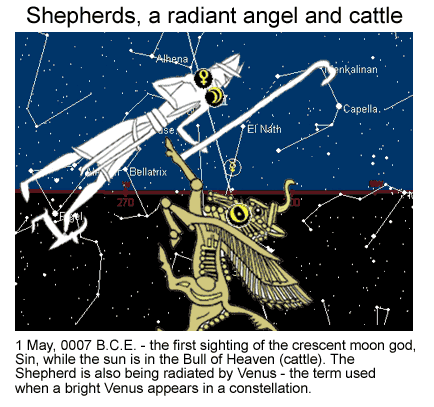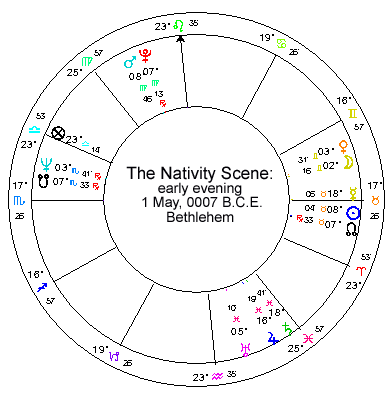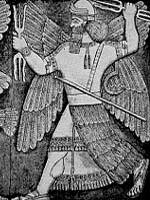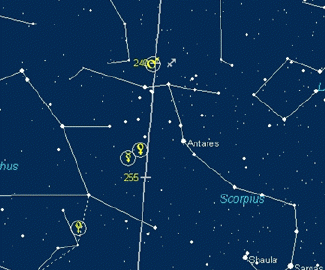Bernadette Brady
December 2005
There are not too many sky narratives left in our culture. We have children’s songs and rhymes about twinkling stars or new moons, we have the sadness of lost love in such songs as “Blue Moon” but generally the sky does not rate too much attention in our oral or written traditions. However, there is one sky narrative which is celebrated every year in the western world and this is the story of the Star of Bethlehem and how it is linked to some shepherds, the journey of three kings and a new born king in a manger.
There are many interesting things about the story of the nativity and a most obvious point is that unlike other birth stories of Emperors and Kings who prefer to locate their stories in the glory of the sun (locating their births at high noon or at the moment of dawn), Christ’s birth story has always been set at night. This night setting hints that the story may well be about the starry sky with the players being stars or planets rather than actual people. Or that it could be a story of the horoscope of the new king, a horoscope not drawn on fragile paper but drawn in the far stronger and longer-lasting medium of story.

The story has two different accounts. One is from the Gospel of Luke (Luke 2:1-20) which gives us half the classic nativity scene. Luke’s story is of a group of shepherds who are out in the fields at night. Suddenly a radiant angel appears in their midst and this angel informs them of the birth of the new king. They are told that this new king can be found in a manger. In contrast, the Gospel of Matthew( 2:1-11) makes no mention of mangers or shepherds but focuses solely on the magi and their interaction with King Herod. The different elements of these two distinct gospel stories have merged in the classic nativity scene of manger, child, cattle, Holy Family, three wise men and a group of shepherds.
But let us unpack this story. In looking to the sky, researchers have appeared to disregard the Gospel of St. Luke and focused on St. Matthew’s comments about a bright star. This star is considered to be the Jupiter-Saturn conjunction amongst the stars of Pisces in 0007 B.C.E. which indeed would have appeared as a bright lone star and would have attracted the attention of the Babylonian astrologers. In contrast to this, St. Luke’s story is not thought to contain any significant sky elements and his comments about Christ in a manger have been interpreted as the birth occurring in a humble cow shed with the excuse that the inn was full. St. Luke’s Gospel therefore is interpreted as a story that emphasises Christ’s humble origins, with the shepherds, at best, symbolising Christ’s link with the Lamb of God or, at worst, nothing but “fillers” in the classic nativity scene.
I believe that St. Luke’s Gospel may also be a sky event but one that describes a Babylonian view rather than the potential Hellenistic view of St Matthew.
Shepherds in the Sky
The Babylonians had eighteen constellations. Three in particular are of interest to the nativity scene. The constellation Orion was known to the Babylonians as the True Shepherd of Anu, where Anu was the location of the sky, meaning the ecliptical area. Opposite Orion, on the other side of the ecliptic, was the constellation that we know as Aurgia, the Charioteer. However, to the Babylonians this was known as the Crook, as in the shepherd’s crook. So this part of the sky was a large image of a shepherd and his crook which stretched across the line of the ecliptic (see the image below).
The Babylonians sky watchers who recorded and collected sky records over many centuries would have considered the forthcoming joining of Jupiter and Saturn as a key event. Their interpretations of both the role of Saturn as king and Jupiter as crown prince may have lead them to expect either a special union of the king with a crown prince or the birth of an undisputed, legal and accepted crown prince. The Saturn-Jupiter conjunction occurred three times from May to early December 0007 B.C.E. and to the Babylonian sky watchers, the whole period of seven months would have been under the influence of this unfolding sky narrative.
One of the times of key observation would have been the first sighting of new crescent moon each month, as this was the birth of the moon god, Sin. Added to this was another sky omen. Any constellation which contained a bright Venus as a morning or evening star received a blessing or radiation from that goddess, particularly if the constellation the Crook received this radiation. For then, according to the Assyrian priest, Bullutu, writing around 679 – 665 B.C.E, such a radiation resulted in the prophecy that “the foundation of the throne will become stable.” (Hunger 1992:73)
With this in mind we can now return to the Gospel of Luke which reported that there was a group of shepherds and that appearing amongst this group was a radiant angel with a message about a newborn king. The shepherds are informed by this messenger that the new born king will be found in a manger. Viewed with an understanding of the Babylonian sky view, we can start to see the possible sky elements in Luke’s Gospel.

In the early evening of the 1 May, 0007 B.C.E. the sighting of the first new moon crescent occurred. This was the first new moon of the period covered by the all-important conjunction and at that time Venus appeared as a bright evening star in the constellations of the Shepherd and the Crook.
So at the time of the beginning of the Jupiter -Saturn conjunction, there was also the radiation of the constellation the Crook, which fulfilling the sky omen of the priest Bullutus.
But the St. Luke’s story may do more then just give us this sky imagery.
Having found a potent time for the birth of a new king, St. Luke’s gospel may also describes the location of the new king, the all important location of the sun. We are told that the new king is resting safely in a manger which could refer to the sun being amongst the stars of the Great Bull of Heaven. He (the sun) is with cattle or in a manger (see image above). Here we can now see all of St. Luke’s story components – the shepherd, the radiant angel and the new king in the manger.

The magi from St. Matthew’s Gospel could be what the Hellenistic astrologer Claudius Ptolemy (87 – 150) defined as a doryphory. Ptolemy uses this technique to define a chart’s fame and rank in society (1917:174). Part of analysing the doryphory is to observe which planets, if any, rise before the sun. Such planets are defined as giving the sun gifts. At sunrise some time after this first sighting of the crescent moon, (chart left) the Jupiter- Saturn conjunction rose before the sun. According to Ptolemy, these two powerful planets are bearing gifts for the new born king. So St. Matthew’s Gospel may well be reporting the sky narrative in the Hellenistic manner, while St. Luke’s Gospel, far from adding trivial background scenery, could be giving us a more detailed description of the sky using Babylonian imagery.
Thus it is quite possible that the classic nativity scene is actually a horoscope which has been written in the medium of story, a medium which has allowed it to carry its sky message over several millennia. So the next time you sing about shepherds who watch their flocks or three kings bearing gifts or the classic children’s carol Away in a Manger or look at a nativity scene in a shop window, step back and look at the imagery in the story and take joy in the role that visual astrology may well still be playing in our culture.
Sources
Hunger, Herman. (1992). Astrological Reports to Assyrian Kings. Helsinki, Finland: Helsinki University Press.
Ptolemy Claudius (1917) The Tetrabiblos. Translator J.M.Ashmand. London: Foulsham & Co Ltd.



